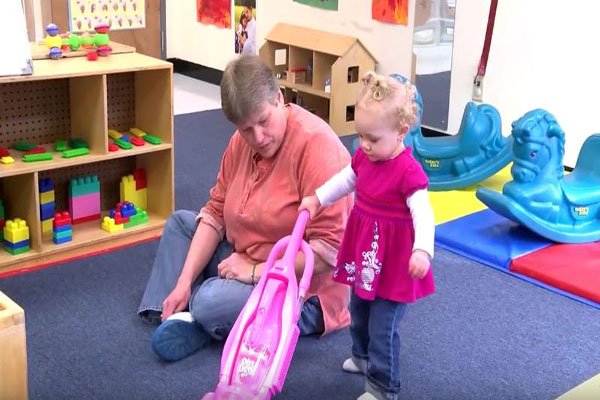We Can Clean Too!: Supporting Pretend Play in the Toddler Room
Download a printable English trancsript or Spanish transcript.
Narrator: Toddlers enjoy pretend play. They often reenact familiar experiences and imitate the words and actions of those around them. These activities benefit their development in many ways. Adults can intentionally plan an environment that invites this type of play, and then be available to support children’s interactions and active engagement.
Heather Mulrooney, Infant Toddler Teacher: With infants and toddlers it’s really important that we’re allowing exploration, allowing them to use objects in various ways, figure out how materials are used.
Infants and toddlers need a lot of new things to keep them interested, to keep them involved. Every two weeks, we really change the environment in our classroom. We also like to provide opportunities based on experiences that infants and toddlers may have had. We chose cleaning in dramatic play. They have been very inquisitive about seeing the teachers clean up and they enjoy helping.
Heather: You want to help?
Child: Yeah!
Heather Mulrooney: So we brought cleaning materials into the classroom. We have multiples of realistic props - that’s especially important in an infant and toddler classroom. So materials are used very differently depending on where children are developmentally: for the infants it may just be exploring that object through touch; for the older toddlers, pushing it and making a vacuum sound; for the older children who are a little more developmentally advanced, really expanding upon their conversation.
Ian: I need water.
Teacher: You need water? What are you going to do with the water?
Ian: Put in the water to clean.
Heather Mulrooney: So and really just going along with that and facilitating that play.
Ian: You need water, too.
Heather: I need water too, ok. Where do I get some water?
Ian: Over there. (points to sink)
Heather: I think we should pretend. Should we maybe pretend to use some water?
Heather Mulrooney: But what else can we use? So we’re going to use sand; we had sand in the sensory table.
Heather: Kelianese, I think, is giving us some water, Ian.
Heather Mulrooney: And just letting them. Going with their imagination, following the child’s lead.
Heather: Do you have something I can use?
Ian: I need a mop.
Heather: You need a mop. Do we have a mop?
Ian: I don’t know.
Heather: Let’s see if we have a mop.
(Ian finds a brush)
Heather: “We can use that Ian, sure. We can use the brush.”
Heather Mulrooney: As the teachers in the classroom we engage and play with them…
Heather: I think we need to clean the floor. Clean, clean, clean the floor.
Heather Mulrooney: …modeling how the materials are used, yet also allowing room for free exploration and imagination with the materials.
Heather: How about if we wash your hands in the sink?
Ian: No.
Heather: No, ok. How are you going to do it?
Ian: Clean my hands. (makes vacuum noise)
Heather: Oh, that’s a great idea!
Heather Mulrooney: And the teachers are individualizing and making an activity interesting and fun that they want to engage in it.



